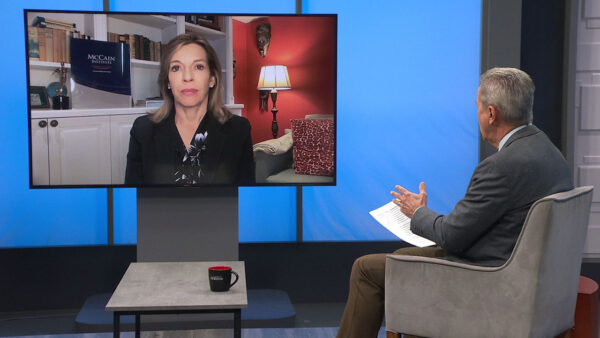CBRE, a firm that produces research data for the real estate market, has released a new report examining the cause of rising construction costs across the U.S. Phoenix was one of 13 metro areas examined. The report reveals that while the construction workforce remains below pre-recession levels, a supply-demand imbalance has led to higher construction wages. Susan LaGanke, senior managing director of project management for the Southwest Region, will tell us more about the report.
Ted Simons: A new report that looks to explain an increase in construction costs in Arizona and other areas have been released by CBRE. Here to tell us what the study found is Susan La-Ganke, senior managing director for CBRE's region.
Susan LaGanke: Thank you very much.
Ted Simons: What exactly did this report look at?
Susan LaGanke: A couple things that we really wanted to focus on was really the market trends? A few factors have changed on the evolution of where the economy tanked to where it is today. So, I think a lot of it is the labor force. And then also, supply and demand. We've seen a pretty big uptick in our construction market for new construction and tenant improvements so we've seen a lack of the number of trades that we really need to complete a lot of those projects.
Ted Simons: How much -- local construction costs, how much are they rising?
Susan LaGanke: You know, they've gone up a few percent. It could be between 5% and 8%. But that percentage can change the entire deal. So it makes a difference even that low percentage.
Ted Simons: Let's talk about the price of construction materials.
Susan LaGanke: We don't see them increasing. Due to more of a global picture. We don't see those increasing. What we're finding is, we don't have enough of the trades to man the jobs that we're producing right now in construction. What we're seeing is the trades are increasing their cost back to us, as is the general contractors.
Ted Simons: As far as manufacturing materials, I thought there was a commodity price, a collapse? No impact on construction cost?
Susan LaGanke: We really didn't see that. Not significant enough to make a difference here in Phoenix.
Ted Simons: The workforce below pre-recession levels?
Susan LaGanke: Significant enough. 30% we're still down, pre-recession. We have seen some of the work come back to Arizona, but not near where we were in the 2004, 2005 and 2006.
Ted Simons: Are you speaking, literally, where did these people go?
Susan LaGanke: They went to other markets that had the demand. We saw a lot of our particular trades head off to Houston, where Houston was very busy and Los Angeles, san Francisco. A lot of the bigger cities, Chicago, Washington, D.C.
Ted Simons: I would imagine that means rages are raising a lot?
Susan LaGanke: Not a lot. A little bit. A little bit can make a difference in a project to a budget.
Ted Simons: Is it true in the southwest?
Susan LaGanke: I think it's a little bit in the southwest. It's bigger in other markets, San Francisco and Los Angeles, had significant increases in construction cost.
Ted Simons: Is immigration a factor in this at all?
Susan LaGanke: I don't believe immigration really is a factor. I think we have the talent that we have. We just don't have enough of it. So, I don't think immigration is really an issue.
Ted Simons: Wouldn't it stand to reason that if the wages are increasing that those folks that did go to D.C. and Chicago are going to come flocking back?
Susan LaGanke: Right. I think we need to do a better job here, ted, of advertising that. We need to tell people we're busy here in Arizona. Please come back.
Ted Simons: As far as single-family home building, give us a better picture here of where we stand. I hear you mentioned -- I hear other people saying, it's back. It's not back nearly as well and all points in between
Susan LaGanke: I think it's back a little bit. Single-family homes is starting to see an uptick. Multi-family has seen a significant increase.
Ted Simons: Is that making up the slack at all?
Susan LaGanke: A little bit. It's a progression. I think it's going to be a progression.
Ted Simons: Is this possibly, as far as numbers of workers and lack there of, is this a new normal?
Susan LaGanke: This is a new normal for Arizona. The entire market has try to understand. We've had so much work for so long, so much work going on with residential, commercial and all of a sudden, it fell off and we're seeing a normalcy that most other markets, they'll see a 3% to 5% increase. So, yeah, we've had to learn how to be a normalized market.
Ted Simons: And we'll have to learn to do that for quite some time.
Susan LaGanke: I believe so.
Ted Simons: I want to go back to something. It rings a bell with construction materials. Years ago, concrete was impossible to get and China was the biggest reason there. Has that changed?
Susan LaGanke: Right now, concrete isn't an issue. We haven't had a shortage of concrete getting into the market. We've had a lot of new construction that's happened. A lot of industrial projects. We haven't seen a shortage.
Ted Simons: That seemed like that was never going to be the case, we could never get enough concrete. You have the concrete and no one do work it. The impact on actual cost of construction, what is the bottom line there?
Susan LaGanke: I think the bottom line is the number of people we need to actually run the projects and be the ones to build them. So I think if we had more of them, we would not see -- we'd see more of an increase. So, our general contractors are increasing their fees right now. There are subcontractors and they are increasing their fee. And us, we're the ones that are paying the price.
Ted Simons: How much more are we paying?
Susan LaGanke: Maybe a few percent more than we did a few years back.
Ted Simons: All right. To take from this report, what do you want people to take from this? What can we do here? Say we're open for business?
Susan LaGanke: I think we do. We need the media's help. We need to do a better job telling people we have work and let people know there's work to be had here. We're welcome all of the trades back to Arizona, as much as we can.
Ted Simons: Let's see what happens here. Good information, good stuff. Thanks for being here.
Susan LaGanke: Thanks very much, ted.
Susan LaGanke: Senior Managing Director of Project Management for the Southwest Region of CBRE























